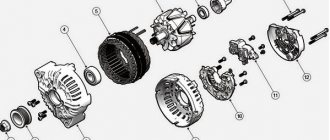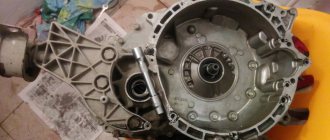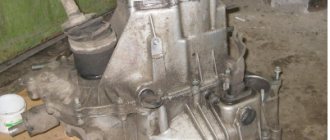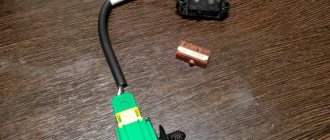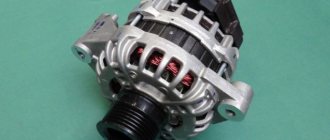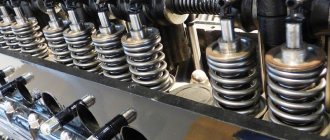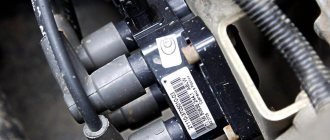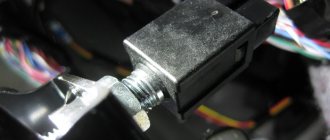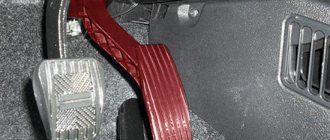Pedals on a Granta To remove the clutch pedal on a Lada Granta car, you must perform the following steps:
- Secure the car on a level surface, squeeze the parking brake lever, and install wheel chocks on the rear row of wheels.
- Using a “14” key, unscrew the three bolts and disconnect the steering shaft (interior of the car, at the base).
- Unscrew the plastic clamp from the clutch cable lead.
Plastic retainer
- Remove the protective bracket and remove the brake pedal vacuum booster pin.
Safety bracket
- We disconnect the block with wires from the dashboard with the sensors on the bracket.
- Using a key set to “13”, unscrew the four nuts and remove the vacuum brake booster.
- Using a “13” wrench, unscrew the five nuts and remove the clutch pedal bracket and brake assembly.
After troubleshooting, we replace the worn elements with new ones and assemble the structure in the reverse order.
Drive system design and symptoms of malfunction
The pushing mechanism is controlled by the leftmost pedal. A well-designed lever ensures easy movement of the exhaust disc petals. In this model of machine, commands to move the fork are sent via a cable. “Go” in a matching shirt. It is worth noting that an automatic cable length adjustment system is implemented here.
Symptoms of a problem
On a new car, the critical pedal assembly moves easily. Violation of factory status requires the cessation of activities and clarification of the reasons. Usually, along with slow speed, related symptoms occur that indicate a malfunction of the assembly module:
- Extraneous squeaks when moving the pedal.
- Sudden pedal movement.
- The need to frequently adjust the minimum lever speed.
- The machine clicks when connecting the box to the motor.
Possible faults
How to fix
| Cause of malfunction | |
| The clutch drives (switching gears is difficult) | |
| Not enough pedal travel | Adjust cable tension |
| Damage (curvature) of the driven disk | Replace driven disk |
| The clutch disc hub is stuck on the input shaft | Clean the splines; if there is severe wear, replace the input shaft and driven disk |
| Curvature of the pressure plate | Replacing the basket pressure plate |
| Damage to the friction linings of the driven disk | Replace the disc and check for axial runout |
| Malfunction of the cable tension mechanism | Replace the cable |
| Clutch slipping (the car does not move when the speed increases and the gear is engaged) | |
| Burning or partial (complete) wear of the friction linings | Replace disk |
| Oily friction linings | Clean the linings, replace worn parts, eliminate the cause of oil leakage |
| Drive jammed | Replace faulty elements |
| Sharp jerks when shifting gears | |
| Disc linings are oily | Clean the linings, replace worn parts, eliminate the cause of oil leakage |
| Drive jammed | Replace worn parts |
| Bent or damaged pressure plate | Replacing the basket |
| Extraneous sounds when turning on speed | |
| Worn or damaged disc damper springs | Replacing the drive |
| Whistle when turning on speed | |
| Worn or damaged release bearing | Part replacement |
Only the main causes of mechanism malfunction are listed; many indirect factors pointing to the same components and assemblies should also be taken into account.
Causes of a tight clutch pedal on a Lada Granta car and ways to eliminate the problem
Problems with a hard lever arise both on new cars and on models with impressive mileage. Depending on the age, the nature of the problem can be different - from a banal clogging wedge to serious problems with the drive connecting the engine and gearbox.
What's the matter
Often a tight clutch pedal on a Lada Granta occurs for the following reasons:
- Poor performance of the diaphragm spring.
- Fork wedging.
- Release bearing jamming.
- Seizures on the surface of the cable in the working sheath.
- The cable is located at an angle in the bracket for attachment to the pedal unit of the passenger compartment.
- Driven disk wedge.
On vehicles with a long service life, cracks may appear in the bearing yoke and release bearing guide. It is also possible that dirt may accumulate in the assembly. Also, damage to the cable mounting bracket should not be ignored.
For your information. All of these problems can come from the manufacturer, allowing faulty parts to be installed.
How to troubleshoot
You should not immediately position the assembly connecting the box and the motor as faulty. The cost of a new set of spare parts in the form of a basket, driven disk and release bearing is high, and until a thorough diagnosis of the drive is carried out, there will not be 100% certainty that there is a problem with this module.
Problems with the drive part
In 80% of cases, the culprit of a tight clutch pedal on a Lada Grant is one of three:
- The cable is unwound.
- Corrosion or dirt in the cable sheath.
- Lack of lubrication on the fork shaft.
In a note. Checking the functionality of the cable part is quite simple. Just step on the pedal and lower it. The return stroke of the lever must be fast and continuous. More detailed diagnostics are carried out when the cable is disconnected. This takes more time, but gives a clear answer to the question. You can check both the condition of the cable and the ease of its movement along the mesh.
However, there are often cases when it is enough to add lubricant to the jacket, and the pedal assembly shows conditional operation. As lubricants you can choose:
- Transmission or engine oil (fill the syringe with a needle).
- Emulsion of silicone origin in a can.
- WD-40.
Fork
The need to lubricate the fork shaft will be indicated not only by a tight stroke. When sending a command to the node, a squeak will also be heard from under the hood. You can deal with this problem using the following method:
- Remove the engine air filter along with the housing.
- Remove the plastic sleeve of the plug.
- Spray with silicone lubricant or WD-40.
Problems with the clutch assembly
When installing a new basket, complex behavior of the part is inevitable. The effect occurs after 500-1000 km in mixed mode. If after running-in the normal operation of the unit is not restored, an unofficial kit with an increased leaf spring stiffness was probably purchased. So there is only one way out - buy a proven set and change it again.
Wear or deformation of the Lada Granta clutch fork also causes a hard pedal stroke and, as a result, discomfort. In this case, it is necessary to act as quickly as possible, since the presence of critical defects can cause the module to fail at the most inopportune moment.
Which bearing is better
Many car owners try to replace it with a “original” part from the car manufacturer. But, for example, domestic spare parts from Lada cannot be characterized as the most durable and durable. Popular models are from the German company Sachs or the official supplier for our AvtoVAZ - the Italian bearing Coram. The price leader is Sachs; this is an inexpensive and acceptable quality alternative to replacing a faulty part. You can also choose EXEDY and SASSONE from more inexpensive models.
Verdict
Poor behavior of the Grant pedal assembly is a malfunction that should be eliminated as soon as possible. The problem may be either in the block, which here is a cable, or directly in the block connecting the motor and the box.
Most often, the problem lies in the cable without a braid or its limited mobility in the jacket. This problem can be fixed by replacing the cable and/or lubricating it with oil, silicone or WD-40. Often the fork shaft needs lubrication.
Less commonly, the problem is caused by a bent or broken plug. Leaf spring wear can dramatically change the force required to release the pedal. A new clutch can also cause driving difficulties.
The Lada Granta is a popular domestic car that has been successfully sold throughout the Russian Federation and even abroad for many years. Each machine has its own weak points, and over time, some complex components inside it may break. The operating conditions of the vehicle are also important. For example, when driving on bad roads or during periods of active use of reagents, car owners face a number of problems.
The clutch on a Lada Grant can fail at the most inopportune moment. Therefore, it will be useful to find out how you can adjust this unit yourself and when it is necessary to completely replace it. Let's take a closer look.
Friction clutch device
The manufacturer installs the same clutch on the Lada Granta as on the Lada Kalina. The mechanism consists of a flywheel with a basket attached to it. The task of the latter is to continuously press the disk with linings made of friction material - this is how the torque from the engine is transmitted to the transmission. A cable-type clutch means that when the pedal is pressed, the cable connected to the clutch fork becomes taut, the paddles stop pressing the disc, and torque from the engine is not transmitted to the gearbox.
The clutch on the Grant has one disc; it is frictional with a central spring in the form of a diaphragm. It is located in a special aluminum crankcase and combined with the gearbox in one housing, attached directly to the cylinder block. For clarity, you can see a detailed drawing of the device.
Lada Granta clutch device
- Drive cable.
- Outer braid of the cable.
- The end of the cable braid is lower.
- Dust cover.
- Metal leash.
- Fork bracket.
- Bearing sleeve.
- Release bearing.
- Casing.
- Diaphragm spring.
- Disk (master).
- Flywheel.
- Friction material linings on the disc.
- Disk (slave).
- Damper spring.
- Rotation vibration damper.
- Disc hub (driven).
- Central spring.
- Cable end.
- Automatic cable tensioner housing.
- Sleeve.
- Fastening the cable braid.
- Pan (crankcase).
- Gearbox input shaft.
On the Lada Grant, the clutch does not require additional adjustment during its entire service life - this is what is written in the car’s operating manual.
Clutch box design "Lada-Grants"
On this car, this unit is no different from the one installed in the Lada-Kalina. This is a flywheel on which a special basket is attached. It must constantly press the disc with the friction linings. Thanks to this, torque is transmitted to the transmission.
As for the clutch cable on the Lada-Grant, in this case this means that when the car owner presses the pedal, the cable connected to the clutch fork is stretched and special petals stop when the pedal is pressed. As a result, torque from the power unit is no longer transmitted to the gearbox.
There is only one clutch disc on the Lada Grant. The same friction unit is equipped with a diaphragm spring. The clutch is combined with a gearbox from one housing.
Which release bearing to choose
Release bearing with fork from Valeo
It is better not to purchase only a release bearing. If clutch elements are from different manufacturers, an imbalance may occur during operation. It’s not difficult to select the entire clutch system kit: focus on popularity among customers, reviews, the name of the manufacturer and the established reputation of the store. A one-piece set of excellent quality is produced by Valeo.
What to pay attention to
There are some signs that the Lada-Grant clutch is not working properly and that action needs to be taken. It is worth noting that if the car has just been purchased, it will be quite easy to press the pedal. If it takes a lot of effort, that's the first sign that the clutch needs to be adjusted or replaced.
It is also worth paying attention to the appearance of extraneous squeaks when the driver presses the pedal. Also, it should not twitch at a time when the car owner is not touching it.
Most often, motorists are faced with the fact that the pedal travel becomes too tight. It is worth considering in more detail the reasons for this problem.
Why has the clutch pedal become stiff?
If the car is new, a so-called wedge may have occurred. This is a simple mistake that you can fix yourself. But if we are talking about an older car, then perhaps the problems are more serious and affect the entire unit.
Most often, such problems arise due to poor performance of the diaphragm spring. The fork may be jammed or the bearing may be jammed. Cable jamming often occurs. This can also jam the driven disk itself.
If the car is used for a long time, cracks may appear on the transmission fork. You also need to understand that over many years of driving a car, a large amount of dirt could simply accumulate in this unit.
If there is a knocking noise after replacing the clutch
As a rule, the cause of knocking after replacing parts is defective parts. In particular, there are dangling damper springs in the driven disk. Therefore, before installing such a spare part on a car, you need to carefully inspect it. Parts of the disk may also be poorly riveted. » alt=»»> Knocks in the clutch area can occur due to a crack in the release bearing bushing (the bushings are often made of plastic). Even at the site where the bushing fits on the flange of the gearbox input shaft, play may form, which also leads to a knocking sound.
The knocking noise occurs due to a broken clutch basket petal, but such a defect occurs infrequently. Another reason for the knocking is a broken starter housing in the Bendix area; it rattles when the car moves. A tooth on the flywheel crown may break off, and it will also knock when touching the rotating parts.
How to solve a problem
First of all, it should be noted that the full clutch on the Lada Grant rarely fails. In 80% of cases, only a specific element needs to be replaced or repaired. For example, the problem is often related to the cable, to corrosion of some parts, or to a fork stem that no longer has the necessary lubrication.
Based on this, some of the most problematic elements can be identified.
To verify the need to repair or replace the clutch cable on a Lada-Grant, a simple check is sufficient. To do this, press and quickly release the pedal. The lever should return to its original position quickly and without vibration. If it jerks and doesn't operate smoothly, the problem is guaranteed to be in that part of the clutch.
more detailed diagnostics are possible. To do this, the cable must be disconnected. It's also a good idea to see how easily it moves across the shirt. Sometimes adding a little lubricant is enough.
Other causes of squeaking
If everything is perfect in the calculations, but the unpleasant sound does not leave you behind, then you need to look for other culprits:
- Plastic pedal bushing. It can “get used” to the bracket and make squeaks. Everything is quite simple here, we are looking for the attachment point, it is probably loose. Let's pull it up. Then be sure to repeat the procedure with the cable
- Tip lead. You will notice this at the first stage. If it squeaks, then it needs to be changed. Fortunately, there are plenty of such parts on sale, and the replacement process itself is not difficult. Unscrewed the old one and screwed on the new one. Then again measure and adjust according to the instructions above
- Loss of input shaft lubrication. This is already a problem with the box itself. Here the solution is clear: lubricant.
Fork
If this element needs to be lubricated, the pedal may also feel harsh. A common sign of a faulty fork is that you constantly hear an unpleasant squeaking sound during operation.
To fix this, you must first remove the entire air filter along with the housing. The plastic sleeve is then carefully pushed away and silicone lubricant is sprayed underneath it. Alternatively, you can use the popular WD40 tool.
Why is the pedal hard on the new clutch?
If the car owner bought a new clutch kit for the Lada Grant, he may encounter such a problem. The fact is that many people prefer to save money and buy spare parts from Chinese manufacturers. They, in turn, deliberately increase the stiffness of the leaf spring. Why is this being done? Everything is elementary. Such manipulations are carried out in order to increase the labor resource of the unit, which, in turn, has worse characteristics than its factory counterparts.
Therefore, when replacing the clutch on a Lada-Grant, it is worth buying higher quality spare parts. It is better to buy all products from the manufacturer.
Clutch cable adjustment
Adjusting the clutch of the Lada Granta begins by pulling the tip of the cable in the direction of its movement, taking into account the fact that the spring will create force. You should fix the cable in this position and start measuring from the front edge of the plastic leash to the clutch fork lever. It should be no more than 2.7 cm. Since there is not much space under the hood, you should prepare a piece of wire of the required length (27 mm) in advance and measure the distance with it.
The leash rotates to adjust the tension. After the clutch cable is released, you need to eliminate the gaps between the driver and the fork lever. Next, the friction clutch pedal is depressed several times - this is how the auto-adjustment mechanism takes its working position - the pedal should not be tight or fall through.
Judging by the reviews of Lada Granta owners, this mechanism is far from ideal and makes various extraneous sounds when you press the pedal - it starts to crunch or click. You can try to get rid of them by increasing or decreasing the distance of 27 mm. You need to select the size individually in each specific case.
Cost of a new node
If we talk about how much a clutch on a Lada Grant costs, then it all depends on the generation of the car, modification and other parameters. For example, if we talk about a car produced between 2011 and 2022, with a displacement of 1.6 liters, then a complete set can cost up to 35,000 rubles. But it is not always necessary to completely replace the entire assembly.
For example, a kit without a release bearing will cost about 5,800 rubles. Therefore, the price of a clutch for a Lada Granta may vary.
Features of correct adjustment of the unit
Very often clutch problems are solved by standard adjustments. However, such measures must be carried out based on the recommendations of experienced specialists and car owners. First of all, you need to turn off the engine. After that, just press the pedal a few times and listen to the sounds. If the squeak is not heard, the adjustment continues.
If the Lada-Grants clutch pedal jams or jerks, its position must be adjusted. First of all, you need to completely squeeze it with your hand. It is better not to use your foot, since in this case it will be much more difficult to feel small cramps or, conversely, jolts when returning the lever to its original position.
If you find that the pedal is slightly compressed, you need to arm yourself with a ruler and determine the distance from the floor to the pedal, or rather the part that protrudes outward. After this, while continuing to hold the meter, the car owner must press the lever and wait for it to return to its previous position. If the values on the ruler diverge or the distance is more than 14.5 cm, then in this case it is necessary to make an adjustment. It should be noted that the full pedal travel should not exceed 146 mm. The cable post cannot move more than 1 inch from the fork arm.
Clutch adjustment methods
All diagnostic and adjustment work is carried out only with the engine turned off. To identify the need to adjust the friction clutch, you should perform a few simple steps. You need to press the pedal two or three times - no knocks, squeaks or other extraneous noises should be heard. The pedal should move freely, without sticking. If you suspect that the pedal is sticking, but visually everything is in order, you should perform the following manipulations:
- press the pedal all the way by hand;
- release the pedal, but do it in such a way that your hand is on it, thereby you can feel its movement, but not interfere with its progress.
You can feel even the slightest jamming or jerking with your hand when the pedal returns to its initial position. If characteristic twitching is observed, it is necessary to make adjustments.
Using a ruler, measure the distance from the floor to the protruding part of the pedal. You need to press it all the way so that it rests on the floor, then release it. The distance is measured again. If the ruler is more than 145 mm, then the pedal free play must be adjusted to normal values.
The pedal's full travel distance should be no more than 146 mm, less is allowed. The cable guide should move relative to the fork lever no more than 27 mm. Normally, the runout of the friction linings of the disc should not exceed 0.5 mm. There must be a distance of at least 0.2 mm between the rivet holding the lining and the lining itself; less is not allowed.
How to replace the cable yourself
In this case, serious manipulations on the part of the car owner will not be required. The first thing you need to do is get into the car and unscrew the nut under the pedal. He is responsible for connecting the cable itself to the main node. After this you will need:
- Remove the outer housing cover from the pin.
- Armed with pliers, remove the holding bracket itself.
- Pull out the lever rod.
- Remove the pedal bracket spring.
- Pull out the bit retainer with pliers.
- Release the pedal.
- Remove the cable sheath gaskets.
The next step is to pull the end of the cable towards you and carefully pull it out of the groove. Subsequently, the tip harness and guide bushing are disassembled. At the final stage, the cable is easily removed by passing through a hole located between the car interior and the engine compartment.
Before installing a new element, it is recommended to lubricate it with machine oil. The cable installation is carried out in the reverse order.
Replacing the release bearing Kalina 2, 1118, Cross, Sport
To make a replacement you will need to put your car on a pit or a lift. Repairs are also possible if you have reliable supports and a jack. It is worth noting that without a pit or lift, the replacement method without removing the box, which is described at the end of the article, is suitable.
How to remove the gearbox and release bearing on Kalina 2 (1.4-1.6 8kl) with your own hands
Replacing the release bearing on a Lada Kalina begins with dismantling the gearbox; this process is described in detail in step-by-step instructions with photos/videos. Perform the operations in order.
- Open the hood of the car and immediately remove the battery.
- Next, remove the air filter by unscrewing the clamp and disconnecting the fastenings to the body.
- The clutch cable is located behind the battery; you need to unscrew the nut and disconnect the cable from the fastener.
- Now disconnect the plug of the speed sensor wire, it is located behind the “engine”, in the area of the pipes.
- The last operations on top of the gearbox are unscrewing the starter and its terminals, as well as disconnecting the clutch cable and electrical wiring.
- Remove the front wheels and tighten the hub nuts. We disconnect the protection (mud flaps) under the wing.
- Immediately disconnect the terminal of the reversing lights wire.
- Nearby there is a suspension beam, first twist the rear nut with a 24mm wrench.
- Now we move on to the ball joints, loosen the nuts and remove them on both sides.
- On the same side of the manual transmission we find the oil drain plug, unscrew it and drain it into any container.
- Between the manual transmission and the engine there is a clutch protective cover. To remove it, unscrew the nuts around the perimeter.
- Let's move on to dismantling the gearshift mechanism. First, unscrew the two bolts and remove the cover.
- Then unscrew the screw that secures the linkage connection.
- The next step is to remove the wheel drive shafts from the gearbox on both sides.
- Let's return to the suspension. On the manual transmission side, it is necessary to unscrew the bolt securing the lever, and also disconnect the extension.
- Next, to remove the gearbox and replace the release bearing of the VAZ Kalina, unscrew the lower bolts securing the gearbox to the engine, as well as the front cushion. Before doing this, be sure to install a support under the engine.
- As a result, the housing of the high-speed unit (MKPP-2181) will be completely disconnected from the mating units, and it can be dismantled. First, use a sharp, wide screwdriver to separate the assembly from the engine.
- Then we manually dismantle the assembly. It is advisable to use a special telescopic stand or ask a partner for help, since the gearbox is not light. After removal, we proceed to replacing the release bearing on the Lada Kalina with our own hands.
Reviews from car owners
If you know the opinion of car owners about this car unit, many note that it often creates problems. For example, some people experience harsh pedal travel or unpleasant squeaking and clicking noises.
However, few people need to purchase a complete clutch kit. Often a specific detail is enough. Therefore, most often it is enough to install a new cable or lubricate the jacket. Therefore, even if this unit fails, repairs will not be as expensive as it might seem.
In general, car owners are satisfied with this car. It is economical and does not require significant maintenance. As long as you don't use it in extreme conditions, there shouldn't be any problems. It also handles well on challenging roads. Many people note that modern foreign cars at the same cost have much worse characteristics. But the opinions of car owners can be divided. Some are not ready to exchange their Zhiguli for anything, others will gladly exchange it for another car.
The device of the "VAZ" clutch cable
If you open the hood, you will notice that the cable sheath is held by bushing 5. Tip 2 is threaded through the slot of the clutch fork. Plastic wire 1 can be twisted or twisted by the tip. This adjusts the "effective length".
Automatic cable adjustment device
Automation can also adjust the cable length. But the limits of “auto-tuning” are small.
The system provides the ability to change the cable length manually. This means that this opportunity must be used.
List of online stores selling parts (Moscow, St. Petersburg, Kyiv regions)
| From 634 | 100 | |
| ASPCC260210 | From 465 | 75 – 80 |
| BRAND 219011602210 | From 300 | 75 — 80 |
| Plastic cable lead | ||
| From 150 | 40 | |
| 21901-1602210-00 | ||
| From 550 – 600 | 75 | |
| 21901-1602210-00 | ||
| —/— | 75 | |
| JSC "ProSport" 26594516 | From 500 | 80 – 85 |
| JSC Vortex 5465465 | From 550 | 80 — 85 |
| № | Name | Address |
| 1. | "Autoall" | www.avtoall.ru |
| 2. | "Original part" | lada-original.ru/ |
| 3. | "Navigator" | www.navigator-63.ru/ |
| 4. | "TOTAX" | totax.com.ua |
| 5. | "Zakupka" | kiev.zakupka.com |
| 6. | "How much" | www.avtostore.spb.ru |
All steps from start to finish
Open the hood and find the gearbox. Snacks will be nearby. All units are closed with a filter that must be removed:
- Disconnect the negative pole of the battery (key “10”);
- We disconnect in turn: the mass air flow sensor connector (oval), the intake valve (press the tongue from the bottom). We also loosen and remove the strapping with thick wire;
Get rid of unnecessary details
"Fork": A plate will be attached to the top of the crankcase, curved with a slot. This is the clutch fork (see photo).
Found the most important detail
Using pliers covered with electrical tape, try to pull the tip forward.
Clutch adjustment on Lada Granta (first method)
Here we will see how to adjust the clutch on a Lada Grant:
- Grasp the end of the cable and pull it forward until it stops.
- Using a caliper, measure the distance from the fork to the plastic leader. The distance should be exactly 27 mm.
If everything is set and checked, measure the clutch pedal travel.
Measuring the distance on the run-out
The distance from the “top point” to the “bottom point” should not exceed 146 mm.
If at the last stage it turns out to be more than 146, the cable must be replaced.
Alternative clutch adjustment method (second method)
No pliers needed here:
- Step 1 is performed as indicated above: pull the tip forward.
- Release the tip and look: if the leader does not fit tightly to the fork, screw it onto the rod.
- Press and release the pedal (3 times), repeat steps 1 and 2.
It turns out the following: when the pedal is not pressed, the leash should be pressed tightly against the metal, while the fork should not be visible. Let the displacement be 1-2 mm.
Clutch adjustment on the Lada Granta is carried out in one of two ways. Moreover, according to reviews, the need arises every 15,000-20,000 km.
How is the clutch adjusted?
So, how to properly adjust the clutch? The clutch of the modern VAZ model family has a clutch cable, along with which there are ratchet mechanisms in the structural unit. These cables do not provide for any clearance, which in theory does not imply the need for adjustment. However, the manufacturer insistently recommends performing periodic adjustment procedures on this mechanism.
To perform the adjustment on these cars, including the Lada Granta, you should stock up on a ruler (a caliper is also suitable) and a screwdriver.
The sequence of manipulations looks like this.
Open the hood of the Lada Grant and install the clutch cable in its original position. To do this, move its lower edge forward until it stops. By moving the cable, you can feel the force created by the return spring. We do not pay due attention to this aspect and continue this manipulation. Taking a ruler or the same caliper, we measure the distance. The photo clearly shows the segment to be measured: between the beginning of the fork and the cable lead. For correct measurements, you will need to keep the cable in a stationary and certain position. The ideal measurement result would be 27 mm. When clutch adjustment is required, the actual parameter will differ from the stated standard. To achieve the required value (27 mm), rotate the cable lead. Having completed this action, insert the cable end into the groove of the fork, and then release the retained element
Please note that there is no gap. This completes the procedure. Now let's move on to pressing the pedal multiple times to make sure the unit is functioning correctly
After completing a set of presses, we once again measure the distance along the cable and, if discrepancies appear, perform repeated adjustments.
The need to adjust the cable on Lada Granta, Kalina or Priora occurs regardless of its condition (new or has already spent a certain amount of service life).
When does the need for adjustment occur?
In such cases:
- when there are jerks from the start that are permanent;
- when an attempt to engage a gear is accompanied by a blow;
- if the pedal is stuck.
These are the most striking symptoms indicating the need for adjustment. Ideally, the level of the pedal should coincide with the brake. In this case, the full pedal travel is 125 - 135 mm. Practice shows that the stroke can be exceeded by up to 160 mm.
To properly adjust the pedal assembly, you will need to stock up on two wrenches with suitable parameters.
- Loosen the locknut holding the cable. It is located on the engine compartment side.
- Now use a wrench to rotate the second locknut to achieve the correct clearance.
- Upon completion of the process, be sure to tighten the first nut to the required torque.
We remind you that efforts should be made to achieve a uniform level in the pedal assembly (the author of the video is Time R).
Why the ECM detects error “P0830”, video explanation
Congratulations to the author! I am also a very bad car enthusiast, albeit with little experience .. I also had a right-hand drive, but, unfortunately, they don’t like our movement. I now have probably the most boring Toyota model. For almost 2 years of owning this car, there were no problems, one since the light bulb in the foot burned out, well, I changed the brakes and oil according to plan, despite the fact that the car is 8 years old, the mileage is about 150 thousand. It accelerates quickly, drives smoothly, the spacious trunk maneuvers, and due to the very comfortable and spacious interior, dad feels comfortable in the back seat quite comfortable, and he is a big man, after a night in the parking lot, blown by all the winds at minus 35, he started up and didn’t even sneeze right away, the stove heats perfectly, the air conditioner cools down quickly, the consumption is 6-7 liters 92 ° in the city the engine is 1.5. 106 horsepower, + due to its size it fits into any parking hole; in short, the car is simply excellent.)))
I have been planning to adjust the clutch on my Grant for a long time. I published your article. Tomorrow I will arm myself with the necessary tools and go to the garage to do everything step by step with my own hands, as described in the article.
When you open the hood, there is a clutch foot under the air filter. Attach the cable with the plastic screw. Using light pressure on the foot, move the cord to the side. Adjust the cable screw and put it back on the leg.
As he drives away, the engine roars loudly from the leveler.
Clutch replacement! Slip!
There are jerks when starting, what could be the problem?
FakeHeader
Comments 26
Thank you all so much for your help, I’ll be calm now) and to know that I’m not the only one

